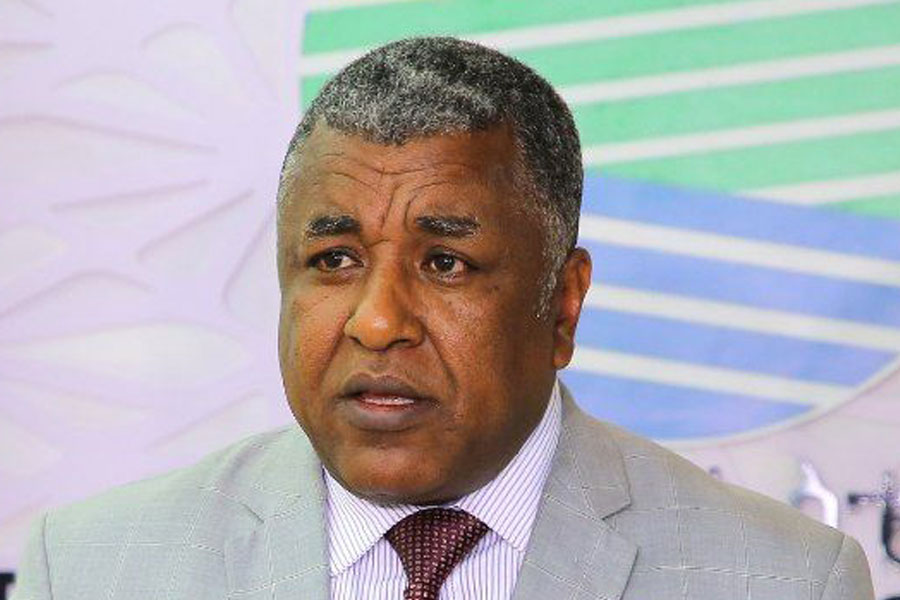
Fortune News | Nov 03,2024
Officials of the Ministry of Agriculture are poised to make a considerable reduction in fertiliser subsidies, potentially by over 50pc this year, in response to the shifting global fertiliser markets and evolving procurement protocols.
The officials' plan, disclosed during a quarterly report released last week, signals an adjustment in subsidies from 1,560 Br for a quintal to 600 Br. The Minister of Agriculture, Girma Amentie (PhD), and his senior officials appeared before Parliament’s Agricultural Affairs Standing Committee, chaired by Solomon Lale.
The move authorities considered strategic arrived on the backdrop of significant reductions in global prices for primary fertiliser components such as urea, previously pegged at 497 dollars a ton. It has witnessed a price plummet by over half, and liquid nitrogen, selling at 536 dollars a ton, observed a decline of nearly 22pc.
Sofia Kassa (PhD), state minister for Agriculture, linked the revised subsidies to a two-pronged strategy: the early procurement of a voluminous 1.3 million tonnes and the implementation of an automated tracking system for each shipment. She stressed her government’s position in the global market.
"International markets dictate us," she told Fortune. "We’re price takers, not setters."
This decision’s backdrop also includes joint initiatives aiming to streamline and strengthen the integrity of the fertiliser supply chain. Joint ventures with Ethio telecom, the Ministry of Innovation & Technology, and the Information Network Security Administration (INSA) have been established, primarily to address concerns about the potential influx of fertilisers through unregulated avenues. Such an initiative, as emphasised by Minister Girma, could bring considerable savings for the government.
Last year, fertiliser subsidies amounted to a hefty 21 billion Br, compelling the federal government to allocate significant budgetary resources. The federal government spent 263.1 million dollars to buy fertiliser during the five months of 2022, a 134pc jump from the same period in the previous year.
“We hope to maintain prices while reducing the subsidised amount,” Sofia told Fortune, providing a window into the Ministry’s forward-thinking approach.
The authorities believe recent shifts in procurement procedures have borne fruit, with the Agricultural Works Corporation continuing to supervise the purchases. Improved market identification and timelines for procurement have been realised, following a substantive reshuffling of the board overseeing procurement. This is of particular significance, given the forex crunch, where supply-demand equilibrium was disrupted, with only half of the required 24 letters of credit opened by May, while it was late for the farming season.
However, with Sofia crediting the role of the revised procurement directive, which introduced a one-month international tendering process and laid down specific restrictions, there is optimism in the official corridor for a more streamlined procurement process.
“Efficient and timely procurement was essential,” she noted.
The state-owned Commercial Bank of Ethiopia (CBE) has opened five letters of credit for the current fiscal year.
Under Girma’s chairmanship, the procurement board, including senior officials such as Mamo Mehretu, central bank governor, Alemu Sime (PhD), minister of Transport & Logistics, Alemtsehay Pawlos, chief of Cabinet, Semereta Sewasew, state minister for Finance, and Abie Sano, president of the CBE appear determined to see the overall procurement process simplified.
Despite the subsidy realignment and procurement reforms, a recent report by Global Market Insight revealed the mounting demand for fertilisers, projecting a 2.3pc annual increase over the next eight years. While global demand shoots up, fertiliser use by Ethiopia’s farmers hovers around a modest 34kg for a hectare. The Oromia Regional State is home to 4.2 million farmers using fertilisers, 95pc channelled through cooperative unions.
Beriso Feyissa, deputy head of the Oromia Agricultural Bureau, drew attention to the current demand-supply disparity in the regional state. Fertiliser requirements are projected at 1.4 million tonnes, but the Ministry’s procurement inches a little over half this. To offset such disparities, the Ministry has advocated a strategic shift towards natural composting.
Close to 1.6pc of Ethiopia’s 15 million hectares of cultivated land has embraced this method. The federal authorities’ push toward alternative solutions, like composting, could indicate a commitment to sustainable and environmentally friendly farming practices.
"We’ve been substituting compost for fertiliser, not alternating it," Beriso told Fortune.
For experts like Ketema Bekele (PhD), an agricultural economist with a 15-year tenure, the inherent limitations of natural compost have prolonged production time, with the need to gradually adapt arable land to chemical fertilisers. The transition could see a yield dip, at least in the short run.
“Farmers need to be made aware,” he said.
Yet, such responses, while seemingly sustainable, are not free from disorders.
The parallel market’s emergence, where a quintal of fertiliser was reportedly traded at 15,000 Br compared to the formal channels, which ranged around 4,200 Br, signified the crisis in managing price volatility and ensuring efficient distribution. Mismanagement in distribution was also acknowledged as a significant concern from the previous year, signalling the importance of tightening supply chain logistics.
An incident in Minjar-Shenkora Wereda in Amhara Regional State last season, where unidentified individuals impounded 1,300qtl of fertiliser, remains a sober reminder of the infrastructural limitations and security risks the industry faced.
Agricultural experts appear divided on the Ministry’s approach.
Ketema believes establishing fertiliser processing plants would present a more sustainable and long-term solution.
One crucial aspect the Ministry could navigate is the seasonal ebb and flow of fertiliser demand. According to people familiar with the industry, there is a spike during the Belg season, when wheat is predominantly farmed. This compels farmers’ unions to tap into the previous year’s reserves as they anticipate fresh procurement, a cycle that demands meticulous planning and forecasting.
In the words of Tesfaye Belayhun, a procurement expert at the Minjar-Shenkora Wereda, who witnessed firsthand the challenges of distribution and supply chain security, “We can’t say there is currently enough stock.”
It is a candid acknowledgement of the concerns ahead but also a call to action for the authorities. This year, the regional state’s Agriculture Bureau allotted farmers who primarily produce teff and wheat 1,000qtl for the current cultivation season despite demand being around eight-fold higher.
PUBLISHED ON
Oct 28,2023 [ VOL
24 , NO
1226]

Fortune News | Nov 03,2024

Fortune News | Jan 02,2021

Fortune News | Feb 05,2020

Fortune News | Jan 13,2024

Radar | Sep 17,2022

Radar | Feb 15,2020

Radar | Jan 09,2024

Fortune News | Jul 30,2022

Radar | Jan 03,2021

Fortune News | May 23,2020

Dec 22 , 2024 . By TIZITA SHEWAFERAW
Charged with transforming colossal state-owned enterprises into modern and competitiv...

Aug 18 , 2024 . By AKSAH ITALO
Although predictable Yonas Zerihun's job in the ride-hailing service is not immune to...

Jul 28 , 2024 . By TIZITA SHEWAFERAW
Unhabitual, perhaps too many, Samuel Gebreyohannes, 38, used to occasionally enjoy a couple of beers at breakfast. However, he recently swit...

Jul 13 , 2024 . By AKSAH ITALO
Investors who rely on tractors, trucks, and field vehicles for commuting, transporting commodities, and f...

Nov 1 , 2025
The National Bank of Ethiopia (NBE) issued a statement two weeks ago that appeared to...

Oct 25 , 2025
The regulatory machinery is on overdrive. In only two years, no fewer than 35 new pro...

Oct 18 , 2025
The political establishment, notably the ruling party and its top brass, has become p...

Oct 11 , 2025
Ladislas Farago, a roving Associated Press (AP) correspondent, arrived in Ethiopia in...